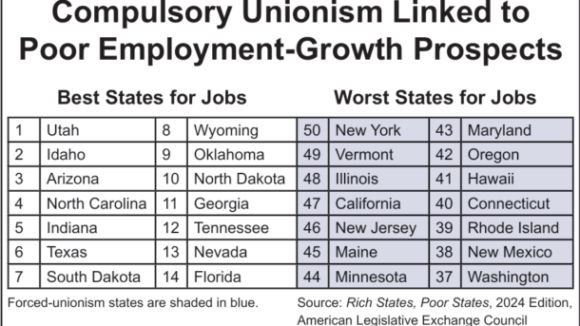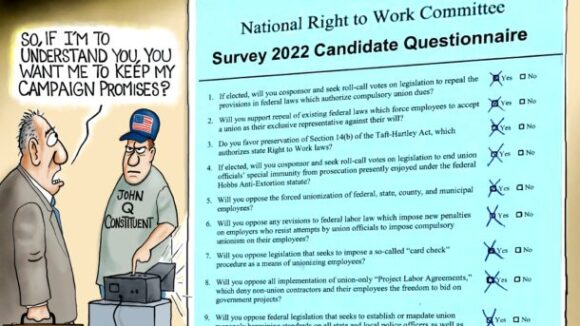Is This Any Way to Run a City’s Schools?
Leaked CTU Proposals Won’t Do Anything to Improve Schools’ Poor Performance

Despite the recent harrowing COVID-19 recession and an increasingly hostile policy environment for job-creating businesses at the national level, the number of employed Americans actually rose faster than the total U.S. population over the past decade.
Right to Work states deserve the lion’s share of the credit.
U.S. Department of Labor data show that the number of civilian household jobs (a broad measure that includes contractors and other self-employed workers as well as workers on employer payrolls) grew by 9.1% from 2011 to 2021.
But the 22 states that already had Right to Work laws on the books in 2011 enjoyed overall household employment growth of 13.2% over the next 10 years.
Meanwhile, aggregate employment in the 23 states that still lack Right to Work protections for employees today grew by just 5.7%, or less than half the Right to Work average.
National Right to Work Committee President Mark Mix commented:
“For decades, Right to Work states have greatly outpaced forced-unionism states in employment growth.
“By 2011, 39.8% of America’s employed population resided in Right to Work states, then 22 in number. That was nearly double the Right to Work share of U.S. employment back in the mid-1950’s.
“Since then, grassroots activists, assisted by the Committee, have increased by five the number of states that ban forced dues and fees as a job condition.
“That’s one key reason why, by 2021, 50.4% of all U.S. workers were employed in Right to Work states.
“A second reason is far superior job growth in Right to Work states.
“From 2011 to 2021, the total number of people employed in the 22 states with longstanding Right to Work laws grew by 7.4 million.
“That’s a 79% larger gain of employment than in the 23 states where forced dues and fees are still permitted.”
“In addition to being correlated with faster job growth,” continued Mr. Mix, “Right to Work is correlated with higher real, after-tax incomes.
“U.S. Census Bureau data, adjusted for interstate cost-of-living differences according to an index calculated by the Missouri Economic Research and Information Center, a state government agency, show that the average after-tax income per person in Right to Work states in 2021 was $54,213.
“That’s roughly $3,400 higher than the forced-dues state average, according to the same analysis, which was recently carried out by the National Institute for Labor Relations Research.”
Today 27 states have Right to Work statutes and/or constitutional amendments.
While federal law has authorized forced union financial support as a job condition since 1935, state Right to Work laws protect the individual employee from being fired or denied a job opportunity for mere refusal to join or bankroll an unwanted union.
Right to Work laws promote fairness and accountability as well as prosperity.
There is simply no credible justification for forcing employees to bankroll a union if they choose not to belong to it.
The fact is, even a number of academic apologists for Organized Labor make no bones about the fact that workers whose productivity is above average typically get paid less when they are unionized.
A case in point is Richard Rothstein, now a distinguished fellow with the union boss-founded Economic Policy Institute.
In a brief survey of union-friendly academic literature on the impact of “exclusive” union bargaining on the pay of employees with diverse levels of skill and industriousness, Mr. Rothstein has written:
“In [unionized] firms, wages of lower paid workers are raised above the market rate, with the increase offset . . . [in part] by reducing pay of the most productive workers.”
Despite the lack of any economic or moral grounds for their stance, President Joe Biden and the overwhelming majority of his fellow Democrats in Congress want to make it permissible for union bosses in all 50 states to pour salt in the wounds of workers who fare worse under Big Labor domination.
Mr. Biden and his cohorts want to change federal law so that union bosses across America, and not just in the 23 states that currently lack Right to Work protections, can add insult to the injuries of the workers they hurt through monopoly bargaining by extracting forced fees from them as well.
Their vehicle of choice is S.420/H.R.842, now sponsored by a total of 261 senators and congressmen.
While proponents label this smorgasbord of special privileges for union bosses as the “PRO” Act, it is more accurately referred to as the Pushbutton-Unionism Bill.
Its core provision would nullify every state Right to Work law on the books, and prohibit the spread of Right to Work protections to new states, by making private-sector forced union fees as a job condition permissible nationwide.
While Speaker Nancy Pelosi’s (D-Calif.) House rubber-stamped H.R.842 last year, today the Pushbutton-Unionism Bill remains stalled in the Senate, thanks largely to fierce opposition mobilized by the National Right to Work Committee.
And even as they continue their fight against S.420/H.R.842, Right to Work members are also fighting to ensure private-sector workers in all 50 states are protected from forced union dues.
So far, Committee activists and their allies have swayed 122 senators and congressmen to sign on to S.406/H.R.1275, the National Right to Work Act.
“The contrast for workers could not be clearer,” said Mr. Mix.
“S.420/H.R.842,” he continued, “is a massive and monstrous scheme handing union bosses sweeping new powers to smother American economic growth.
“Worst of all, it would destroy the 27 Right to Work laws that now safeguard the liberty of most American employees.
“But S.406/H.R.1275 consists of just 166 words and does one simple thing: It lets workers choose for themselves whether a union deserves their support.
“Throughout this spring and summer, Right to Work members will keep turning up the pressure on their elected officials in Washington, D.C., to support this bill.
“Every member of Congress needs to understand that, if he or she wishes to be known as a Right to Work ally, it is not enough to oppose appalling Big Labor power grabs like the Pushbutton-Unionism Bill.
“It is also necessary to support rolling back union officials’ special privileges, including, first and foremost, the privilege to force employees to pay for union monopoly bargaining they never asked for or wanted, on pain of termination.”
This article was originally published in our monthly newsletter. Go here to access previous newsletter posts.
To support our cause and help end forced unionism, go here to donate.

Leaked CTU Proposals Won’t Do Anything to Improve Schools’ Poor Performance

Wherever Big Labor wields the power to collect forced union dues, union bosses funnel a large share of the confiscated money into efforts to elect and reelect business-bashing politicians. Employment growth tends to lag as a consequence.

Members Insist They Keep Pro-Right to Work Campaign Promises